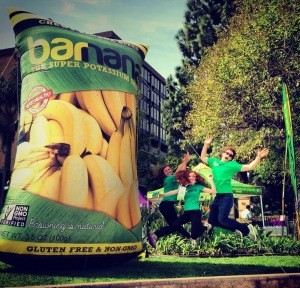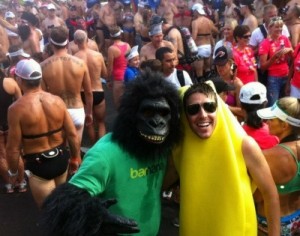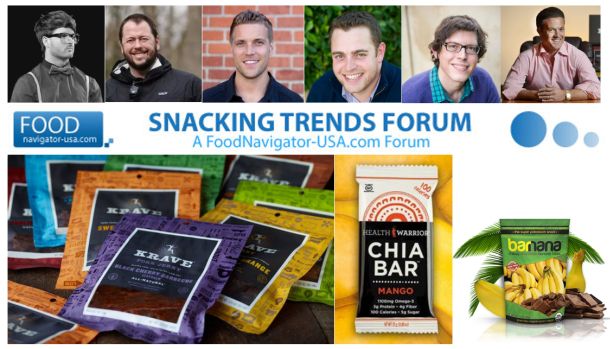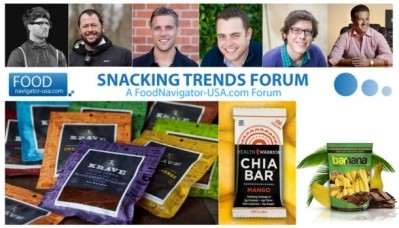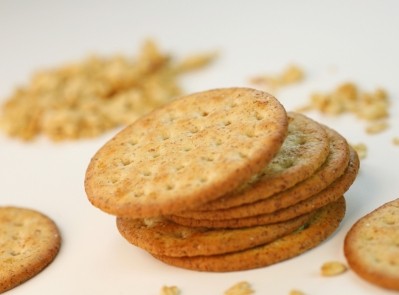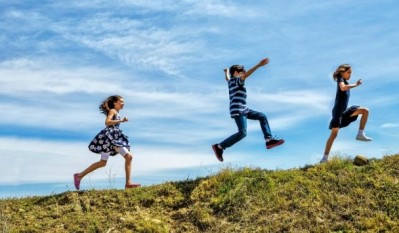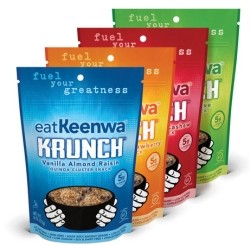Barnana co-founder talks guerrilla (and gorilla) marketing, and standing out from the crowd in healthy snacks
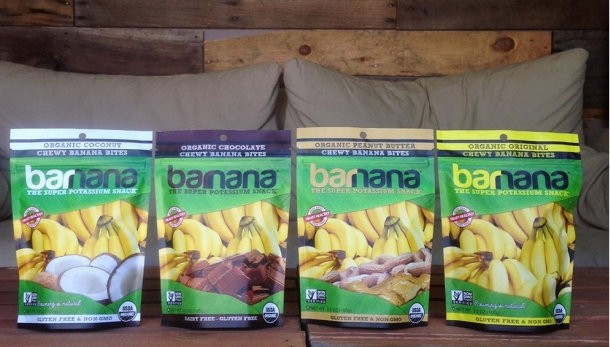
“When you don’t have a big marketing budget, you’ve got to try and do crazy things that will get you a ton of attention, so guerrilla marketing is at the core of what we do,” says Nik Ingersoll, CMO and co-founder at Santa Monica-based Barnana, which launched its snacks at the Expo West show in 2012, and is now in 2,500+ stores from Safeway and Wegmans to Whole Foods, Sprouts and Vons.
The firm is also talking to distributors that can get the Barnana brand into a range of other channels from movie theaters (“so there’s something else to eat besides M&Ms,” says Ingersoll) to gyms, hotels and airlines (in new single serve packs).
Guerrilla marketing is at the core of what we do
While Barnana’s break dancing gorillas and other crazy antics have generated great brand awareness at trade shows, its penchant for large inflatables has also proved a cheap, but effective way to draw attention to the brand, says Ingersoll.
Perhaps the most memorable example was in Hawaii’s Big Island last fall, when Ingersoll and co-founder and COO Matt Clifford paddled out into the bay at 4.30 in the morning to attach a giant 20-foot inflatable banana to an anchor to greet competitors in the swimming leg of the Ironman World Championships.
“We didn’t want a lack of capital to restrict what we do,” Ingersoll told FoodNavigator-USA, “so we always try to think like Macgyver and be as creative as we can on a limited budget.”
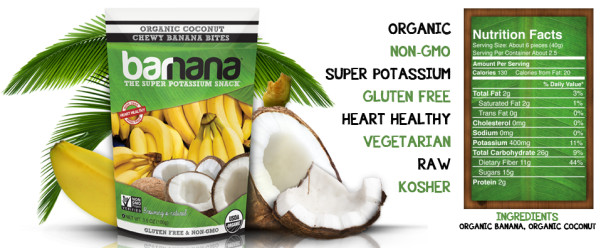
We’ve turned bananas into a portable snack with an 18-month shelf-life
And so far, it’s paying off. Barnana revenues are set to top $2m in calendar year 2014, and within 3-4 years, reckons Ingersoll, barnana could be a $30m+ brand.
Which is not bad going considering that it is actually a surprisingly simple snack.
Indeed, the original variant only has one ingredient: organic bananas, which are gently heated at less than 104 ̊F (so they can be marketed as ‘raw’) in solar powered ovens to remove most of the water, chopped into pieces by the firm’s partners in Latin America, and then shipped over to California to be packaged.
“We’ve turned bananas into a portable snack with an 18-month shelf-life.”
Each 40g serving of the original chewy snacks contains 140 calories, 2g protein, 800mg potassium and 4g of fiber and no added sugar, preservatives, colors or flavors.
“The banana is America’s #1 selling fruit, but no one’s really branded it,” says Ingersoll. “There are huge companies in fresh bananas [Chiquita, Dole, Del Monte], but in snacks, all you have is banana chips. We want to be the brand people associate with bananas. We want to do for the banana what POM Wonderful did for the pomegranate.”
We want to do for the banana what POM Wonderful did for the pomegranate
Barnana is the brainchild of the firm’s founder & CEO Caue Suplicy, a triathlete who used to snack on partially dehydrated bananas when he was growing up in Brazil, and hooked up with Clifford and Ingersoll to take the concept to the US market in 2010.
"There were dehydrated bananas in South and Central America but they had not made their way to the US market," recalls Ingersoll.
"In the US, there were only banana chips and chocolate covered banana products on the market when we entered. There was an under-served niche market that we found in banana-based products."
But why the dearth of banana snacks given the popularity of fresh bananas? "It was not a lack of demand, not that [dehydrated bananas] looked strange, or that no one had done it somewhere else in the world before; it's that no one branded that product well and pushed it into the American market with passion [until Barnana]," he says.
The same could be said of coconut water, he adds. "Until the likes of Vita Coco and Zico brought the South American product into the US market."
We remove about 85% of the water
It took two years - much longer than they originally expected - to get their ducks in a row, find organic growers to work with (Barnana now works with nine growers in Brazil, Ecuador and Peru), find a co-manufacturer in the US to pack the products, and come up with a brand and packaging that they thought would appeal to consumers, says Ingersoll.
The key was getting the "perfect heat/air ratio and drying time down", says Ingersoll. "We remove about 85% of the water give or take a couple percent variability."
So by the time they arrived at Expo West in 2012, they had burned through pretty much all of their cash.
But the product was an instant hit, and by the time the show was over, Suplicy et al had orders from scores of retailers, including Wegmans, which wanted the products in all 82 of its stores, followed by Whole Foods in Northern California, and the tiny Barnana team went into overdrive (“work, sleep, work sleep - my social life was pretty much dead, but it was worth it” says Ingersoll) to deliver on its promises.
My social life was pretty much dead, but it was worth it
In the next two years, they got a “ton of advice” from food industry veterans such as Jerry Bello, who now sits on the board along with Pat Finn from Finn Capital Partners and Scot Cohen, founder of V3 Capital Partners. They also hired an experienced sales director (Scott Presnall), and honed their pitch to investors, attracting around $500,000 in the first financing round and $1m in the second.
Potential investors, he says, want the hard data on your run rates at particular retailers and clear evidence that you are making progress, but “the #1 question they ask is ‘why are you raising money’?” he says.
While this might seem like an obvious question (after all, you have to speculate to accumulate), they want to establish how capital efficient you are (whether you have put the money you’ve already burned through to good use), and whether you can present a clear path outlining how you are going to go from $2m to $25m to $50m,he says.
“We run a pretty lean operation.”
Click HERE for more information.
Ingersoll is speaking at the FoodNavigator-USA snacking trends forum on March 18. Register HERE!
